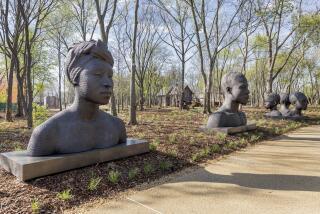Capitol Art Collection’s Focus on Whites Challenged : Washington: Tour guides say that more and more visitors, especially minorities and foreigners, are raising questions about the lack of diverse images.
- Share via
WASHINGTON — Homer Fleetwood was enjoying himself, touring the U.S. Capitol, taking in the fabulous collection of statues and busts, oil paintings and frescoes. Then it hit him: Where are the images of black Americans?
“I didn’t mean to notice it,” said Fleetwood, 48, a graduate student in American history at Howard University in Washington. “But it just struck my mind. There are African-Americans who have made tremendous contributions to the arts, the sciences and the industrial development of this country. I didn’t see a statue of Mary McLeod Bethune. I didn’t see a statue of Thurgood Marshall. I didn’t see a statue of George Washington Carver. It’s time for the statuaries to reflect the composition of the nation.”
Fleetwood is not alone. Capitol tour guides say that more and more visitors, especially minorities and foreigners, are raising questions about the art collection’s lack of diversity.
It is a collection, art scholars acknowledge, that largely highlights famous white men and their achievements, more reflective of post-colonial history and 19th-Century attitudes than today’s multiculturalism.
Each day, as many as 10,000 visitors tour the Capitol, where they can see historic figures such as Andrew Jackson, Jefferson Davis and William Jennings Bryan memorialized in bronze; Samuel Adams, Benjamin Franklin and John Hancock lionized in marble.
Hanging over the east staircase in the Senate wing is “Battle of Lake Erie,” William Henry Powell’s vivid oil painting of Oliver Hazard Perry’s dramatic victory over the British fleet during the War of 1812. In the third-floor west corridor of the Senate wing hangs Charles Willson Peale’s portrait of George Washington resting his hand on the barrel of a cannon after winning the Battle of Princeton.
Although there have been contemporary additions to the Capitol’s art collection--a portrait monument to the women’s suffrage movement and a bust of Dr. Martin Luther King Jr., for example--the contributions of many Americans to the nation’s history are not reflected here.
“Clearly, (the collection) needs to be broadened,” said Sen. Ben Nighthorse Campbell (D-Colo.), the only Native American in Congress, “just like the U.S. Senate needs to be broadened to include other perspectives.”
Of the roughly 700 pieces of art in the Capitol, Native Americans are represented in 35 pieces, blacks in 10, according to the Capitol architect’s office. And in many of those representations, critics complain, Native Americans and blacks serve as unidentified props. One example is John Blake White’s painting of American revolutionary commander Francis Marion inviting a British officer to share a meal being served by a black man.
Six years ago, when Campbell was a freshman House member on what was then the Interior Committee, he got a painting removed from the committee’s hearing room in the Longworth House Office Building. The painting, called “Death Whoop,” depicted a knife-wielding Native American brandishing the scalp of a white man.
“It disturbed me just to look at it,” Campbell said, “and I knew other Indians would be disturbed.” “Death Whoop” had hung unchallenged for nearly a century.
In her book, “Art & Empire: The Politics of Ethnicity in the United States Capitol, 1815-1860,” art historian Vivien Green Fryd describes how in many paintings “Indians are relegated to shadows and borders, to circumstances of less power than Europeans and settlers, and to positions that augur their diminishment and disappearance.”
She also writes that the “virtual absence of blacks from the Capitol decoration throughout the 19th and 20th Centuries suggests that those in power have never felt comfortable acknowledging the reality of slavery in the United States.”
There is no overall count of art by gender, but only seven of the approximately 190 statues and busts in the Capitol are of women, although the most visible statue, “Freedom,” is a female form. It has been removed temporarily from its place atop the Capitol dome for restoration.
More to Read
Sign up for The Wild
We’ll help you find the best places to hike, bike and run, as well as the perfect silent spots for meditation and yoga.
You may occasionally receive promotional content from the Los Angeles Times.






